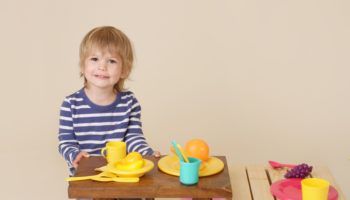By Natalie Grebe
As a program quality assessor, I have the opportunity to observe some stellar vignettes in classrooms that highlight developmentally appropriate practices. During one of my visits, I was busy circulating among the busy activities of a pre-kindergarten classroom. When I approached the block center I became enthralled by my findings. Three, four-year-old children were busy working together trying to create an elaborate block structure. Many different shaped wooden unit blocks were being used as the chosen medium. With a block in hand, each child was contributing to the construction of a special, structural design. The blocks were being arranged in a long row across the spacious area and were being stacked on top of each other to add height. The tops of the towers were adorned with symmetrical designs. One child suggested that an airplane be added to the runway. The boys scurried to the shelves, which were labeled with the shape of the blocks, to take hold of more blocks to put their plan into action.
During this time, the teacher, who was a bystander, decided to insert herself into the block area to learn more about their block building experience. The conversation was initiated by the teacher asking the children what they were building. The children were so excited to tell her about their structure and continued to add their personal experiences about flying to different places. Many back and forth conversations occurred with the teacher pausing to allow each child to share.
At this time of the construction, the children were working on forming the outline of a plane and discrepancies arose about the next step. The teacher listened to the children’s different views to see if they would reach a consensus. Acting as a facilitator, she asked the children where they could find information about an airplane. One child suggested looking in the classroom library for a book about airplanes. About two minutes later, he hurried back to the center grasping a book picturing a variety of airplanes.
The construction of the airplane continued as the children used the photos in the book as a resource. The body of the airplane was formed by enclosing blocks to form a rectangular shape and seats were added inside the plane by using small square blocks. A child placed one play person on each square block and the other two children added road signs and vehicles to the outskirt of the runway.
The clean-up bell rang and a five-minute warning was provided. The children expressed their disappointment by pouting and verbally shared with the teacher how they wanted to save their airport to play with it during afternoon centers. The teacher suggested that the children create a sign to display on their structure to let others know that they wanted to save it. She guided the children with forming letters that read, “Ths is our arprt. Plez sav.” (“This is our airport. Please save.”)
What was the teacher’s role in creating this safe and developmentally appropriate environment for the children to freely explore the world of block play?
- Set up a functional area for block play. The area should be a larger space to accommodate the type of play, have a flat surface, and be out of a high traffic area. A variety of blocks (unit and hollow) should be accessible on low shelves for the children to explore. To assist in efficient clean-up and to develop organizational skills it is beneficial to have the blocks stored on shelves labeled with the outline of the shape. Accessories (cars, people, and animals) are essential for more imaginary play.
- Show interest in the block center! This is the best incentive for block play. Children at a young age enjoy playing with their teachers and it provides opportunities for the teachers to model how to use the materials, assist in making clean-up a game instead of a chore, facilitate learning, and observe and evaluate the children’s academic and social skills.
- Be an active observer and know when to insert yourself into the children’s play. Survey the scene first and then find an area in the block center to sit and to help the children with language to collaborate and to negotiate. Remember that the teacher’s interactions are not to direct the play or resolve problems for the children. Be the facilitator, converse, guide the children, and know when to exit their play experience.
- Ask open-ended questions to encourage more conversation and an opportunity to expand on the children’s thought process. Be sure to focus on the process of building, not the final product.
- How did you know how long to make the runway?
- I noticed that you used different shaped blocks on top of the structure. What are the names of the shapes and why did your towers not fall down?
- What would happen if your ramp was elevated instead of flat?
- How can we make a bridge that goes over the structure?
- If both of the towers have the same number of blocks, what makes this one taller? Why did you build towers and how are they used?
- Are the wings of your plane shaped the same way as the wings of the plane pictured in the book? Why or why not?
- How do you know how many people can fly in the airplane?
- Allow children enough time to build and explore. The children worked hard to collaborate and construct their designs. Remember that they need time to play with their structures after they build them. Children like leaving structures up during naptime or overnight when possible.
- Provide pictures of real life structures to copy. Children will use blocks to represent things they know, like cities, cars, airplanes, and houses. Also, take photos of the children’s structures and write captions about what they built and display them in the classroom.



